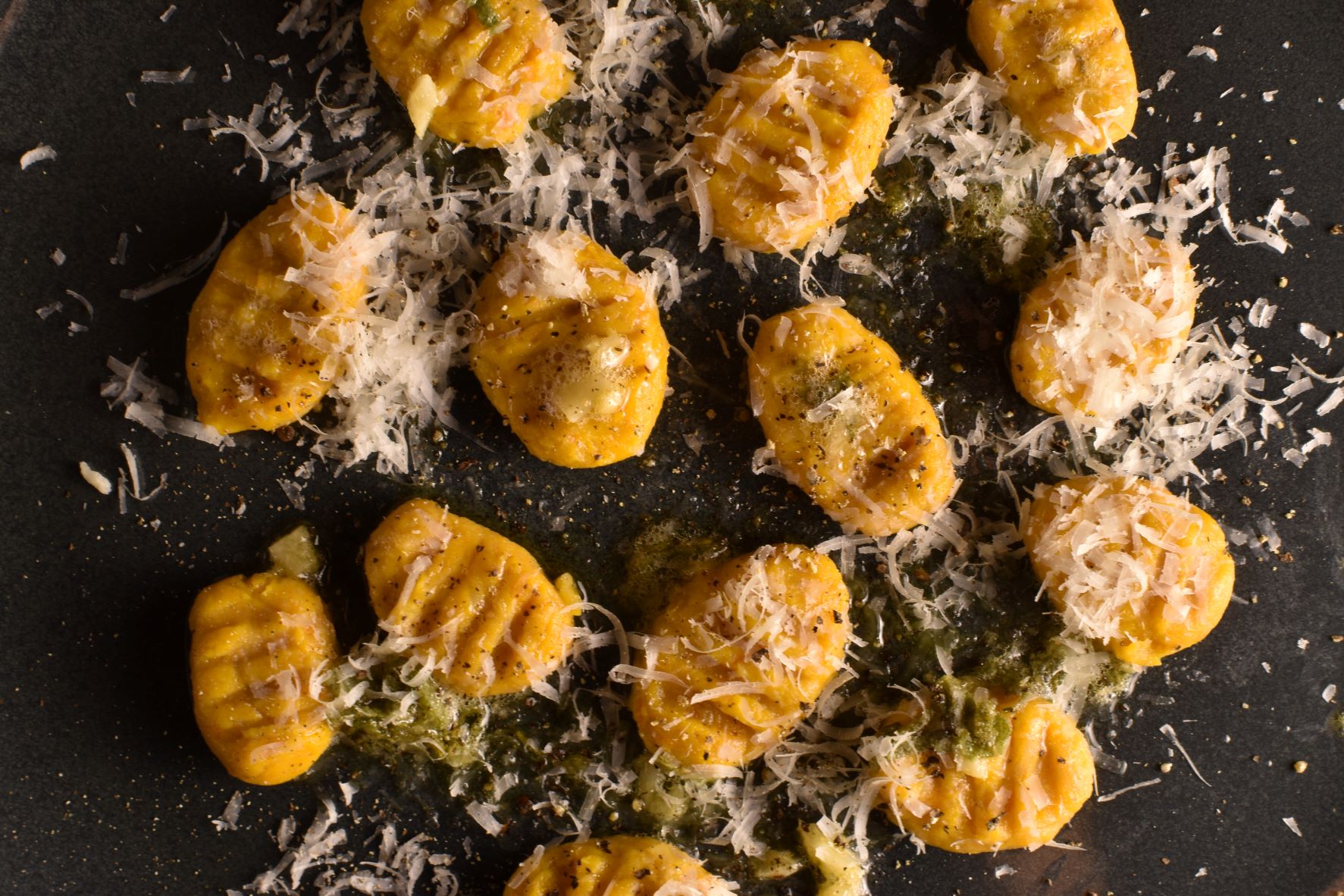The combination squash-butter-sage is simply magic!!!
ingredients for 4 servings (cost about 4 € pp)
- Salt
- 250g flesh of hokkaido squash
- 250g potatoes
- 100 g flour
- 1 egg
- 1 garlic clove
- 80 g butter
- Fresh sage leaves
- 40 g parmigiano cheese
- Black pepper
Gnocchi are a kind of fresh pasta, made with flour and potatoes or with flour and ricotta or with ricotta and spinach or with many other vegetables and herbs. Ready-made gnocchi are available on the market, but their quality cannot ever reach the handmade ones. Today we will prepare gnocchi with potato and squash. We will follow the same rules and the same procedure with the potato gnocchi.
We first of all roast the squash (salted and cut in pieces) at 170 C, in a baking pan with lid. We want the squash to be very very tender, without “burnt” points which they would create lumps. So, count about 40 to 50 minutes. We take the squash out of the oven, then we put it in a sieve and with a pestle we try, pressing it, to remove as much liquid as possible. We melt the squash very well.
Meanwhile we boil the potatoes. We also gently fry a garlic clove, crushed and unpeeled in the butter. When it turns gold we remove it and we fry the sage leaves.
We use the oldest potatoes we have, as we need as much starch as possible and also as low humidity as possible, so that we would have to put as little flour as possible.
We boil the potatoes for the gnocchi ALWAYS with the skin, ALWAYS starting from cold water and ALWAYS in non salted water for about 40 to 50 minutes till very very tender. We peel them and we make them a purée. The purée should be as fine as possible without any hard pieces or lumps as our gnocchi pasta must have a silky texture. Therefore, it is obligatory to pass the purée for our gnocchi through a fine chinois, in order to ensure that there will be no pieces of potato left.
We have also to knead the potato – flour “dough” as less as possible, as the excessive kneading makes the gnocchi elastic, industrial and “cheap”. It is evident that the use of immersion or any other electrical component is prohibited, if we want our gnocchi not to remind us …….. potato-flavoured bubble gums.
We must use the less flour possible, as much flour turns the gnocchi gummy and reduces their potato purée filling. So use as less flour you can. Yes, I know that without flour the dough cannot be formed to small gnocchi as it has to be. That´s why it is added a small amount of it. And don´t mind if your homemade gnocchi are not perfectly shaped. The important is to be tasty and “fluffy”. The industrial ones contain a lot of flour and also other stabilizers, in order to be perfectly shaped. Your gnocchi must not have this awful texture.
A trick to form gnocchi without using a lot of flour is to freeze the dough for 30 minutes. The cold “pasta” can then be cut and formed much easier.
So, when the purée and the squash are prepared we put them in a bowl with some salt and we slowly add the flour and the egg, beaten.
Αfter mixing the flour and the potato, we make thin rolls from the dough mixture, which we then cut into small olive-sized pieces. With a knife, we make some stripes on their upper part. We add flour at the gnocchi, so that they do not stick and we let them rest for more than 30 minutes, so that the moisture is distributed inside them.
Gnocchi must have a uniform texture and relatively equal size, so they must prepared at the same time but in slightly different shapes so that they do not look industrial. If our gnocchi have different texture or size, some will come out overcooked and some uncooked.
We boil the gnocchi little by little in well-salted water. In total, gnocchi will take about 2 minutes to boil. The traditional rule requires that we remove the gnocchi as soon as they rise to the surface of the pot, I leave them a little longer.
We drain them and we carry them in the pan with the garlic butter and the sage. We stir the gnocchi carefully and we put them in plates.
We add some very finely ground parmigiano and black pepper and we serve.


